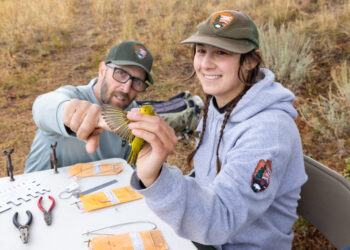By David Tucker EBS Contributor
At the Jan. 19 Big Sky County Water and Sewer District board meeting, when the topic turned to water-supply exploration on Lone Mountain, Mark Cunnane of Western Groundwater Services uttered a sentence that caught my attention.
“Conservation is our best option,” Cunnane said.
While that’s a slight paraphrase, you can see why my ears perked up. As the district searches for additional sources of fresh water, it’s becoming increasingly clear that there isn’t much to go around.
The upper Gallatin River watershed’s topography and geology make finding and accessing water very difficult. The region’s rock layers have folded, bent, compressed and protruded. Water doesn’t flow easily through this maze, and what water has been discovered is laced with harmful chemical elements like arsenic. This water could be treated and used for household consumption, but that process would be expensive and is less than desirable.
Water supply in Big Sky is directly tied to whatever is available in these underground aquifers, which refill over time through snowmelt and rain. To this point, water users on the Big Sky Water and Sewer District system have gotten their water from shallow aquifers in the meadow areas near the Town Center and the Meadow Village, and wells higher up on Lone Mountain. Residents and businesses on private water systems or individual wells draw from a variety of sources, but all are underground and recharged by natural precipitation.
The water in these aquifers is extremely high quality, but the supply is limited and likely to dwindle as climate models predict less snow in the years and decades to come. While more rain is predicted, much of this quickly runs off to surface waters before penetrating into the groundwater aquifers, thus future recharge may be inadequate to satisfy demand.
Because groundwater like our aquifers is inextricably linked to surface water like the Gallatin River, household water supply and use have profound impacts on river water quality and quantity. Many water-quality issues are caused by or compounded by inadequate in-stream flows, and inadequate in-stream flows can be caused by excessive groundwater withdrawals. Already we have seen evidence of withdrawals in the Meadow Village minimally impacting in-stream flows of the upper West Fork.
One way to keep the Gallatin healthy is to, as noted above, conserve—and not just in our homes. Residential conservation efforts are critical to keeping water in the ground, and by association in the river, but more actions need to be taken across Big Sky’s water-management infrastructure.
Leaks are a major source of water waste, and something that is relatively easy to fix. For your home, the Gallatin River Task Force can issue leak-testing kits that can identify problem areas in your household fixtures. On the community-system scale, operators should be regularly checking for and repairing issues as they arise. Some are already doing this, such as the Big Sky’s water and sewer district and the Yellowstone Club, but efforts should be expanded to capture as much wasted water as possible.
In addition to better leak management, we need to adopt efficiency standards on an industrial scale. The Task Force offers residents cash rebates for swapping in-home fixtures like toilets and showerheads for more efficient models, but all new development should be required to incorporate these standards. Destination visitation is still our only major industry here in the upper Gallatin watershed, and large hotels and hospitality businesses can make a significant difference.
While some view water conservation as enabling more development—the argument being that the more water we save, the more we can use—the truth is that even at the current build out of Big Sky, we will need to adopt significant water-conservation policies to keep the Gallatin River clean and our drinking water healthy.
As it stands, we are likely using more than the Gallatin can spare, and a Gallatin devoid of clean, cold water is no Gallatin at all. It can’t sustain wild populations of trout. It can’t support downstream agricultural operations. And it can’t drive our robust outdoor-recreation economy. To give it a fighting chance, conservation is our best option.
David Tucker is the communications manager for the Gallatin River Task Force.













